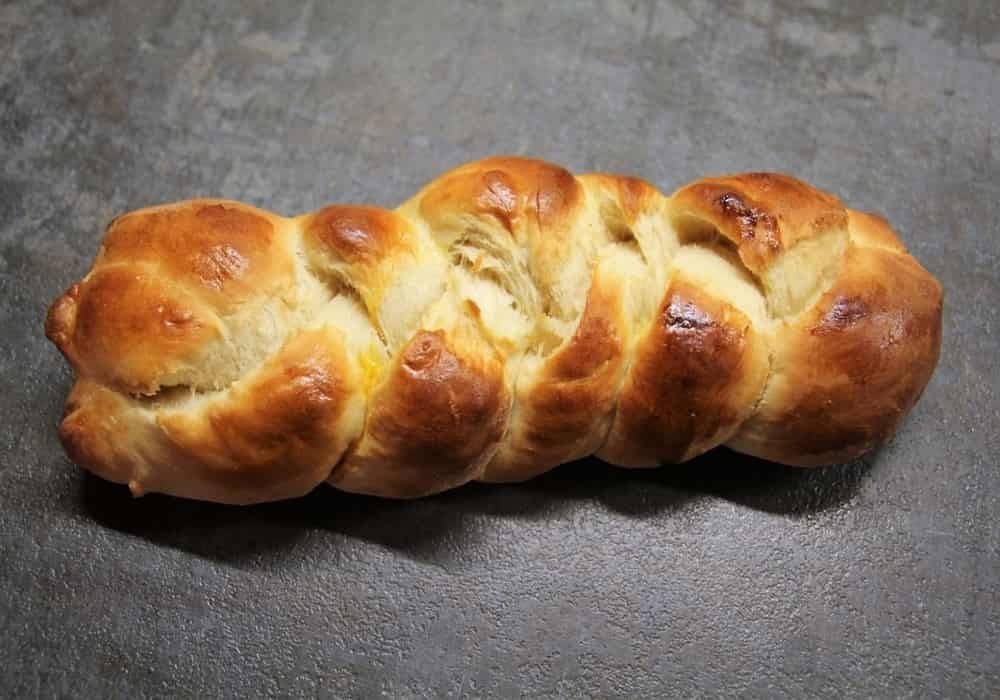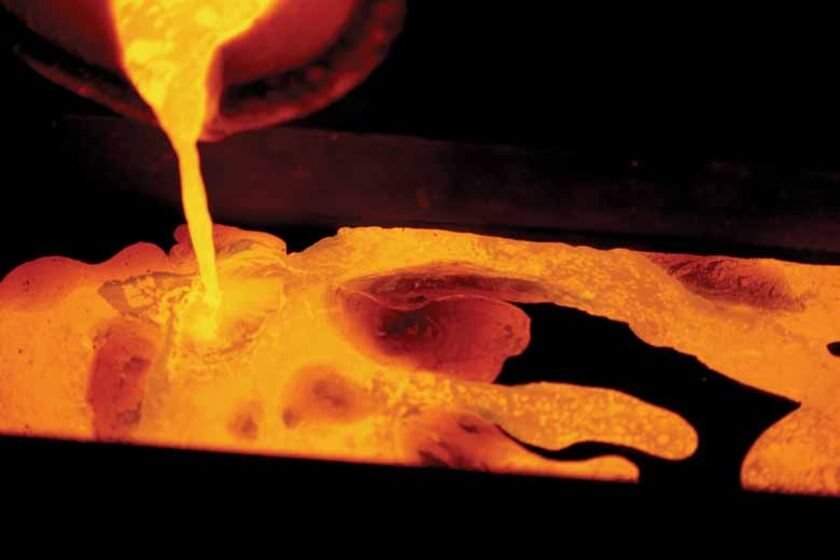Polymerization
Polymerizations is a general collective term for synthesis reactions that convert similar or different monomers into polymers.
Technical polymerisation reactions are mostly used for the synthesis of plastics; they can be divided into chain polymerisation and step growth reactions.
Chain polymerizations (also called chain growth reactions in English literature) take place via an active chain end. They can be divided into radical, cationic, anionic and coordinative chain polymerizations.
Step growth reactions (called step growth polymerization in English literature) take place via polycondensation (also called condensation polymerizations) or polyaddition (also called addition polymerizations).
In the textile industry, polymerization is the chemical process by which resins or plastics are attached to textiles by means of heat.
Biological polymerization
In living beings , polymerization reactions are used, among other things, for the synthesis of DNA and proteins. They proceed according to different and much more complex mechanisms than those listed above. They usually contain a temporary complex formation with a matrix. In protein biosynthesis, for example, the mRNA serves as a template that forms a complex with ribosomes. The sequence of the template is then transferred to the newly formed polymer. The extremely complex mechanisms allow a high degree of control over the final polymer.
Biological polymerization reactions have so far only been made technically useful in a few cases, for example in the polymerase chain reaction or in the enzymatic polymerization of technical polymers.
The term plastic covers polymerization products
The term plastic includes synthetic or semi-synthetic polymerized products. They are formed from organic condensation or polymer addition and may also consist of other substances to improve performance or economy. There are several natural polymers that include plastics. Plastics can be formed into synthetic films/fibers etc…
Types of reaction
Addition and condensation
An addition polymerization occurs when the monomer molecule becomes part of the polymer without loss of atoms, that is, the chemical composition of the resulting chain is equal to the sum of the chemical compositions of the monomers that make it up.
A polycondensation occurs if the monomer molecule loses atoms when it becomes part of the polymer. Usually a small molecule, such as water, is lost.
Condensation polymerization generates by-products.
Staged and chain growth
In chain growth polymerization the monomers become part of the chain one at a time. Dimers are formed first , then trimers , then tetramers , etc. The chain increases one by one, monomer to monomer. Most chain growth polymerizations are by polyaddition.
In polymerization by growth in stages (or steps) it is possible for an oligomer to react with others, for example a dimer with a trimer, a tetramer with a dimer, etc., so that the chain increases by more than one monomer. In staged growth polymerization, the growing chains can react with each other to form even longer chains. This applies to chains of all sizes. In a chain growth polymerization only monomers can react with growing chains. Most stage polymerizations are by polycondensation.
Techniques for polymerization reactions
Many techniques are used for polymerization reactions. All the techniques have the same objective of characterizing the specific structural and physical properties of the polymer.
Techniques for addition reactions:
- Bulk: Pure liquid monomers react to form polymers, including PVC or LDPE.
- In solution: the monomer and initiator are dissolved in a suitable solvent and the polymer is formed in solution. The polymer can be recovered by evaporation, or stored in solution for use in coatings and adhesives. Polymers such as polyacrylic acid are generally made via solution polymerization reactions.
- Suspension: Insoluble monomers are dispersed in an aqueous solution and small spheres of polymer form in the solution after the start of the reaction. Small, uniformly sized polystyrene beads are formed through suspension polymerization reactions.
- Emulsion: Insoluble monomers are dispersed in water as emulsions in the presence of a surfactant and individual high molecular polymer microparticles are formed (latex). Paints and coatings, as well as adhesives, are widely used products formed via emulsion polymerization reactions.
Techniques for condensation reactions:
- Melt: All reactants are mixed together neat and the reaction temperature is raised above the melt temperature of the resulting polymer. Polyester and polyamide fibers are formed from melt condensates.
- Condensation in solution: all the reactants (monomer, catalyst) are mixed together in an unreacting solvent. Synthetic elastomers are formed through condensation reactions in solution.
- Condensation during interphase: the polymerization reaction takes place and the resulting polymer resides at the interface of two immiscible phases. Polyanilines and polyimides are often formed via condensation reactions during interphase.
What are the important elements to measure during polymerization reactions?
Whether the polymerization is by addition in a chain reaction or by condensation in a step reaction, a good understanding of the chemical process is essential to advance research and / or rapidly commercialize new polymers.
This understanding encompasses the following knowledge:
- Conversion rate of the reaction.
- Monomer conversion rate and reactivity ratios.
- Relationship and influence of reaction parameters on the distribution of molecular masses.
In-depth understanding of the reaction mechanisms during the initiation, propagation and conclusion phases. - Overall structure of the polymer for the needs of target applications.
- In more complex polymerizations such as those resulting in copolymers or multipolymers, measuring the individual polymerization reaction rates of different monomers allows researchers to refine and control the physical properties of the final product. Understanding the essential reaction parameters of polymers allows precise control of step-wise polymerizations, measurement of residual monomers in real time and finally improvement of polymer properties at the end-use stage.
Questions and Answers
This set of Polymer Engineering Multiple Choice Questions & Answers (MCQs) focuses on “Techniques of Polymerization-1”.
1. Which of the following initiation mechanism in vinyl polymerization, does not produce a pure polymer?
a) initiator decomposition
b) uncatalyzed thermal initiation
c) uncatalyzed photochemical initiation
d) all of the mentioned
Answer: a
Explanation: For uncatalyzed vinyl polymerization done thermally or photochemically, the polymer produced is very pure and free from any contaminants, while the use of initiator leaves the polymer impure due to the presence of traces of initiator in it.
2. Teflon is the polymer that results from the polymerization of tetrafluoroethylene. Write a chemical formula for this reaction. What are some of the properties of Teflon?
Answer:
n(CF2 = CF2) � (—CF2–CF2—)n. Teflon is highly resistant to chemical attack and has a very low coefficient of friction (it is slippery). In addition, it can be used over a very wide temperature range (-73 °C � 260 °C).
3. What may be the consequence of the uncontrolled vinyl polymerization with excessive rise in temperature?
a) discolouration
b) thermal degradation
c) branching or cross-linking
d) all of the mentioned
View Answer
Answer: d
Explanation: If reaction is left uncontrolled, excessive increase in the temperature at local points called ‘hotspots’ can cause discolouration, thermal degradation, branching of polymers and sometimes even cross-linking, giving rise to the formation of polymer of inferior quality.
4. Head-to-tail polymerization of propylene is observed with the [cp2Zr(R)]+ catalyst. Explain this result on the basis of molecular-level interactions.
Answer:
Each incoming propylene molecular orients with its methyl group in toward R, rather than out toward cp, in order to avoid unfavorable contacts with the bulky cp’s. When the R group migrates to propylene, it migrates to the closer olefinic carbon, which is always the one bearing the methyl group (the “b carbon”).
5. Why does heat dissipation in bulk polymerization becomes progressively difficult with high conversions?
a) increase in medium viscosity
b) solubilization of polymer in the monomer
c) precipitation of polymer in the monomer
d) all of the mentioned
View Answer
Answer: d
Explanation: The stirring process and heat dissipation become progressively difficult due to gain in viscosity medium or due to solubilization or precipitation of polymer in the monomer, more so in higher conversions.
6. Consider a homogeneous zirconium catalyst in which two cyclopentadienyl ligands are connected by a —CH2–CH2— bridge. Which symmetry elements does the (bridged-cp2)Zr moiety possess? What is the expected tacticity of the polypropylene produced using this type of catalyst? Why?
Answer:
The (bridged-cp2)Zr moiety possesses both C2 and mirror plane symmetry. Like the parent unbridged cp2Zr catalyst, it would be expected to produce atactic polypropylene, since the methyl group on the propylene would have no up/down preference.
7. Which of the following monomer mixture is used in bulk polymerization?
a) undiluted monomer
b) monomer –solvent mixture
c) monomer-water mixture
d) none of the mentioned
Answer: a
Explanation: Bulk polymerization is the polymerization of undiluted monomer and is the simplest technique of polymer synthesis.
8. Consider the polymerization of vinylidene chloride, CH2=CCl2. What structural variations are possible in poly(vinylidene chloride)?
Answer:
Orientation of the monomer units along the chain.
9. How is the solvent in solution polymerization, more useful to overcome the disadvantages of bulk polymerization?
a) it reduces the viscosity gain
b) increases the rate of reaction
c) causes chain transfer
d) all of the mentioned
View Answer
Answer: a
Explanation: The solvent reduces the viscosity gain, thus allowing more efficient stirring of the medium and proper heat dissipation of the heat liberated. The chain transfer to solvent causes a problem for solution polymerization.
10. We learned that chemists can control the properties of polyethylene by choice of appropriate catalysts and reaction conditions. What are some other ways in which chemists can manipulate the properties of polymers?
Answer:
By using different monomers. For example, the incorporation of a phenyl (C6H5) unit into the monomer leads to polystyrene, while the incorporation of a chloro (Cl) group leads to PVC, a polymer with very different properties.
By using different fabrication techniques. For example, polystyrene can be glassy or foamy depending on how it is fabricated.

